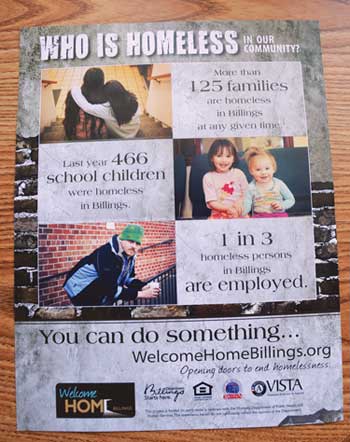University Communications and Marketing
MSUB students help city craft awareness campaign on homeless issue
June 27, 2012
Contacts:
Dr. Sarah N. Keller, MSU Billings Communication Dept., 896-5824
Lynda Woods, City of Billings, Community Development Division, 657-8284
Dan Carter, University Relations, 657-2269
MSU BILLINGS NEWS SERVICES — The message is simple but powerful: “we can do something.”
The dual purpose of crafting a modest but commanding message is at the heart of a media campaign developed by health communication students at Montana State University Billings in collaboration with the city as part of a long-range plan to combat homelessness.
 Students in Dr. Sarah Keller’s health communications class worked this past spring
semester to produce a media campaign to address public stigma against the homeless
as part of a partnership with the city’s Community Development Division. A print advertisement
and TV public service announcement designed by the students was launched Tuesday at
the Montana Housing Partnership Conference held in Downtown Billings. The conference
continues through Thursday at the Crowne Plaza.
Students in Dr. Sarah Keller’s health communications class worked this past spring
semester to produce a media campaign to address public stigma against the homeless
as part of a partnership with the city’s Community Development Division. A print advertisement
and TV public service announcement designed by the students was launched Tuesday at
the Montana Housing Partnership Conference held in Downtown Billings. The conference
continues through Thursday at the Crowne Plaza.
The media pieces are designed to help promote the community’s response to homelessness and introduce a new web site, which will serve as a gateway for information and services regarding homelessness in Billings, Keller said.
One goal of the campaign is to challenge stereotypes about homelessness, she said. Popular notions include that the homeless population is mostly composed of single adults — typically men — who are middle-aged or older. In fact, data show that at any given time, there are about 125 homeless families in Billings and more than 450 children are homeless over the course of a year. Youth under the age of 18 account for 40% of the total homeless population in Billings, city officials say.
And, according to Lynda Woods with the city’s Community Development Division, many of the homeless in Billings are not panhandlers looking for money. About a third of the homeless population in Billings are actually working, but making ends meet with friends, relatives or in shelters. The annual cost to the city of helping the homeless amounts to about $54 million.
“We can’t afford not to develop a community response to this issue,” Woods said at the housing conference on Tuesday.
Keller said the student-led project aimed to increase public empathy for the homeless by putting a new face on the homeless population. Student Andrew Doer, a singer-songwriter and undergraduate at MSU Billings, composed and produced a song for the campaign, “You or Me,” to convey the message that anyone could end up homeless with a turn of misfortune. He is scheduled to perform the song at “Rocking and Rolling,” a benefit the Tumbleweed Runaway Program supporting homeless youth in Billings. The benefit will be held at Bones Brewing Co., on Aug. 8.
Undergraduates and graduates in the class began the project by meeting with experts, including Woods and AmeriCorps VISTA volunteer Andrew Proctor. Comparable prevention campaigns from around the country were reviewed to obtain ideas for the local effort.
MSU Billings students also conducted in-depth interviews and focus groups with members of the Billings general public to obtain a more accurate understanding of public attitudes towards the homeless and barriers to supporting homeless services. The local advertising effort will be out this summer.
For more information on the city’s homelessness effort, go to http://ci.billings.mt.us/index.aspx?NID=1522.
